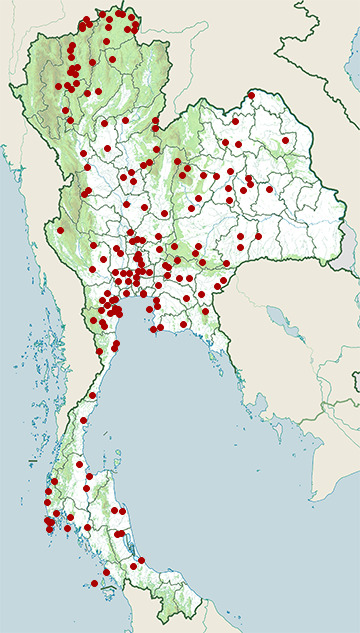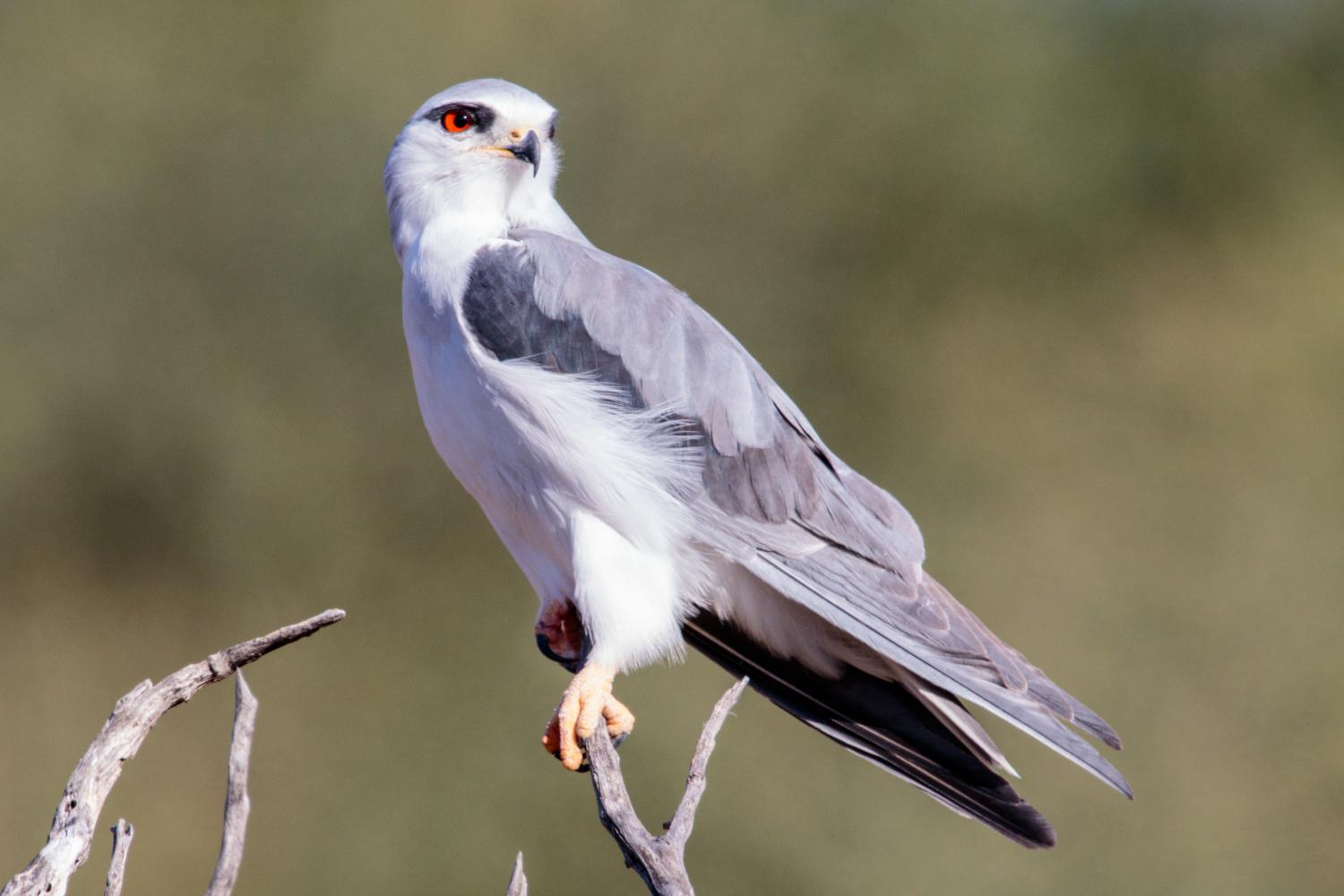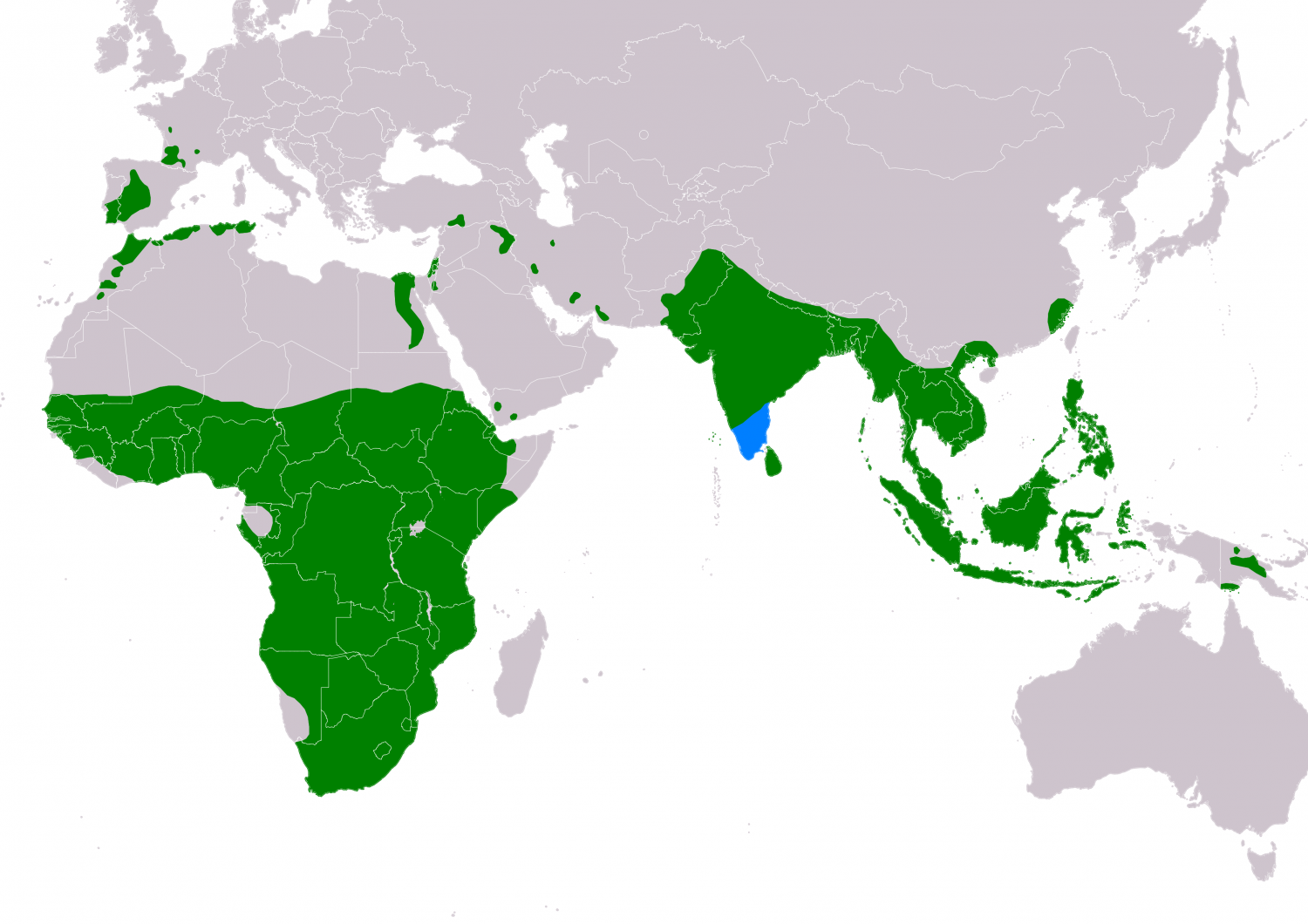Species of Thailand
Black-winged kite
Elanus caeruleus
René Louiche Desfontaines, 1789
In Thai: เหยี่ยวขาว
The black-winged kite (Elanus caeruleus), also known as the black-shouldered kite (not to be confused with the closely related Australian species with the same name), is a small diurnal bird of prey in the family Accipitridae best known for its habit of hovering over open grasslands in the manner of the much smaller kestrels. This Palearctic and Afrotropical species was sometimes combined with the Australian black-shouldered kite (Elanus axillaris) and the white-tailed kite (Elanus leucurus) of North and South America which together form a superspecies. This kite is distinctive, with long wings; white, grey and black plumage; and owl-like forward-facing eyes with red irises. The owl-like behaviour is even more pronounced in the letter-winged kite (Elanus scriptus), a nocturnal relative in Australia. Although mainly seen on plains, they are sometimes seen on grassy slopes of hills in the higher elevation regions of Asia. They are not migratory, but show nomadism in response to weather and food availability. They are well adapted to utilize periodic upsurges in rodent populations and can raise multiple broods in a single year unlike most birds of prey. Populations in southern Europe have grown in response to human activities, particularly agriculture and livestock rearing.
Taxonomy
The black-winged kite was described by the French naturalist René Louiche Desfontaines in 1789 and given the binomial name Falco caeruleus. It is now one of four species in the genus Elanus which was introduced in 1809 by the French zoologist Jules-César Savigny. The genus Elanus is distinctive in having very small scales covering the foot and on the underside, scutellate scales are found only under the terminal phalanges. The claw lacks a groove on the underside. The word Elanus is from Ancient Greek for a "kite". The specific epithet caeruleus is the Latin for "blue".
There are three subspecies:
- E. c. caeruleus (Desfontaines, 1789) – southwest Iberian Peninsula, Africa, southwest Arabia
- E. c. vociferus (Latham, 1790) – Pakistan to east China, Malay Peninsula and Indochina. The underwing secondaries are smoky grey and nearly white in the nominate subspecies.
- E. c. hypoleucus Gould, 1859 – Greater and Lesser Sunda Islands, the Philippines, Sulawesi and New Guinea
Description
This long-winged raptor is predominantly grey or white with black shoulder patches, wing tips and eye stripe. The long falcon-like wings extend beyond the tail when the bird is perched. In flight, the short and square tail is visible and it is not forked as in the typical kites of the genus Milvus. When perched, often on roadside wires, it often adjusts its wings and jerks its tail up and down as if to balance itself. The sexes are alike in plumage. Their large forward-facing eyes placed under a bony shelf that shades them is distinctive; their velvety plumage and zygodactyl feet are characters shared with owls and the genus has been considered as a basal group within the Accipitridae. They are thought to have been adapted for living in savanna habitats where seasonal rodent population peaks occur. Such food resources are also favoured by the owls. The inner vanes of the feathers have velvety barbules. They have a diploid chromosome number of 68 (some older studies claimed 64 for E.c.caeruleus and 66 for E.c.vociferus) with a distinct karyotype with resemblances to the kites and honey buzzards and suggesting a basal position within the diurnal birds of prey.
Distribution and habitat
The black-winged kite is a species primarily of open land and semi-deserts in sub-Saharan Africa and tropical Asia, but it has a foothold within Europe in Spain and Portugal. The species range appears to be expanding in southern Europe and possibly in West Asia. The first records of breeding in Europe were in the 1860s and since then they have become more widespread and populations are on the rise. It is thought that land-use changes, particularly agriculture and pastureland have helped the species.
Several geographic populations have been named as subspecies and these include the nominate subspecies which occurs in Spain, Africa and Arabia. The subspecies vociferus is found east of this range across South Asia and into Southeast Asia. Along Sumatra, Java, Borneo and the Philippines subspecies hypoleucus (sometimes considered a full species) includes the population wahgiensis described from New Guinea. Subspecies sumatranus is not always recognized. The white-tailed kite and the black-shouldered kite were formerly included with this species but have since been treated as separate species.
Although found mainly on the plains they have been seen at higher altitudes in Sikkim (3650 m ft abbr=on), the Nilgiris (Doddabetta, 2670 m ft abbr=on) and Nagaland (2020 m ft abbr=on).
They are said to be winter visitors in some parts of their range such as the Western Ghats.
Behaviour and ecology
The black-winged kite breeds at different times of the year across its range. Although nesting has been noted throughout the year in India, they appear not to breed in April and May. Males establish territories and defend them from competition. Females move into the territories of males. Studies in Africa found that males were more numerous than females. Courtship is noisy and involves chases and once the pair is formed they copulate frequently. The nest is a loose platform of twigs in which 3 or 4 eggs are laid. The female spends more effort in the construction of the nest than the male. The eggs are pale creamy with spots of deep red. Both parents incubate but when the chicks hatch, the male spends more time on foraging for food. Females initially feed the young, sometimes hunting close to the nest but will also receive food from the male. After fledging the young birds continue to be dependent for food on the male parent for about 80 days, initially transferring food at perch and later in the air. Young birds have reddish brown feathers on the upperparts and on the breast. The reddish colour is derived from porphyrins and is thought to provide the young birds some camouflage. Once breeding is complete females often move on to new territories sometimes deserting before the young fledge, leaving males to feed and raise the young. Both males and females show considerable nomadism. Unlike most birds of prey, they are capable of raising multiple broods in a year, and young birds are known to disperse widely, adaptations that helps them utilize periodic rodent population surges. Their opportunistic breeding capabilities are also accompanied by irregular patterns of moult. Young birds show "arrested" moult, retaining feathers for a season and then rapidly moulting them in a serial descendent pattern, where more than one primary feather is moulted at the same time. The adult plumage is found after two years.
Their prey includes grasshoppers, crickets and other large insects, lizards, and rodents. Injured birds, small snakes and frogs have also been reported. The black-winged kite flies slowly during hunting like a harrier, but it will also hover like a Kestrel. It has on rare occasions been known to hunt prey in flight. Perches are used for hunting and for feeding but large prey may sometimes be handled on the ground. In southern Africa, they appear to favour roadside verges for foraging and are sometimes killed by collisions with vehicles.
These birds roost communally with groups of 15 to 35 (larger numbers in Europe) converging at a large leafy tree. They are extremely silent and the calls recorded include a high-pitched squeal or a soft whistle. They call mainly during the breeding season and at the roost site.
A species of nematode, Physaloptera acuticauda, has been recorded as a parasite of the species in South Africa. A trematode species, Neodiplostomum elani, has been described from a black-winged kite type host from Chandigarh. A feather louse Degeeriella elani is known from the species.
The soft feathers of black-winged kites can lead to adherence with some grass seeds which may be dispersed by the species. However such seeds can pose the risk of entangling their wings.
This article uses material from Wikipedia released under the Creative Commons Attribution-Share-Alike Licence 3.0. Eventual photos shown in this page may or may not be from Wikipedia, please see the license details for photos in photo by-lines.
Category / Seasonal Status
BCST Category: Recorded in an apparently wild state within the last 50 years
BCST Seasonal status: Resident or presumed resident
Scientific classification
- Kingdom
- Animalia
- Phylum
- Chordata
- Class
- Aves
- Order
- Accipitriformes
- Family
- Accipitridae
- Genus
- Elanus
- Species
- Elanus caeruleus
Common names
- English:
- Black-shouldered kite
- Black-winged kite
- French: Elanion blanc
- Thai: เหยี่ยวขาว
Synonyms
- Elanus melanopterus, Leach (1817)
- Elanus cæsius, Marie Jules César Savigny (1809)
- Falco melanopterus, François Marie Daudin (1800)
- Falco vociferus, John Aubrey Clarendon Latham (1790)
- Falco cæruleus, René Louiche Desfontaines (1789)
- Elanus melanopterus
Photos
Please help us review the bird photos if wrong ones are used. We can be reached via our contact us page.
Range Map

- Amphawa District, Samut Songkhram
- Ao Phang-Nga National Park
- Aranyaprathet District, Sa Kaeo
- Ban Chang District, Rayong
- Ban Laem District, Phetchaburi
- Ban Lat District, Phetchaburi
- Ban Phai District, Khon Kaen
- Ban Sang District, Prachinburi
- Bang Ban District, Phra Nakhon Si Ayutthaya
- Bang Len District, Nakhon Pathom
- Bang Pa In District, Phra Nakhon Si Ayutthaya
- Bang Pahan District, Phra Nakhon Si Ayutthaya
- Bang Phra Non-Hunting Area
- Bang Pu Recreation Centre
- Bang Saphan Noi District, Prachuap Khiri Khan
- Bangkok Province
- Borabue District, Maha Sarakham
- Bueng Boraped Non-Hunting Area
- Chaiya District, Surat Thani
- Chatturat District, Chaiyaphum
- Chiang Dao District, Chiang Mai
- Chiang Dao Wildlife Sanctuary
- Chiang Khong District, Chiang Rai
- Chiang Saen District, Chiang Rai
- Doi Inthanon National Park
- Doi Lang
- Doi Lo District, Chiang Mai
- Doi Pha Hom Pok National Park
- Doi Suthep - Pui National Park
- Doi Tao District, Chiang Mai
- Don Chedi District, Suphan Buri
- Fang District, Chiang Mai
- Hang Chat District, Lampang
- Hat Yai District, Songkhla
- Huai Chorakhe Mak Reservoir Non-Hunting Area
- Huai Krachao District, Kanchanaburi
- In Buri District, Sing Buri
- Kabin Buri District, Prachinburi
- Kaeng Khoi District, Saraburi
- Kaeng Krachan District, Phetchaburi
- Kaeng Krachan National Park
- Kamphaeng Saen District, Nakhon Pathom
- Kantharawichai District, Maha Sarakham
- Khao Laem National Park
- Khao Phra - Bang Khram Wildlife Sanctuary
- Khao Phra Thaeo Wildlife Sanctuary
- Khao Sam Roi Yot National Park
- Khao Sanam Prieng Wildlife Sanctuary
- Khao Soi Dao Wildlife Sanctuary
- Khao Yai National Park
- Khao Yoi District, Phetchaburi
- Khlong Luang District, Pathum Thani
- Khok Sung District, Sa Kaeo
- Khon San District, Chaiyaphum
- Khuan Khanun District, Phatthalung
- Khun Chae National Park
- Khun Tan District, Chiang Rai
- Klaeng District, Rayong
- Ko Sichang District, Chonburi
- Kui Buri National Park
- Kumphawapi District, Udon Thani
- Laem Pak Bia
- Mae Ai District, Chiang Mai
- Mae Chan District, Chiang Rai
- Mae Fa Luang District, Chiang Rai
- Mae Ping National Park
- Mae Rim District, Chiang Mai
- Mae Taeng District, Chiang Mai
- Mae Wong National Park
- Mu Ko Phetra National Park
- Mueang Chachoengsao District, Chachoengsao
- Mueang Chaiyaphum District, Chaiyaphum
- Mueang Chiang Mai District, Chiang Mai
- Mueang Chiang Rai District, Chiang Rai
- Mueang Chonburi District, Chonburi
- Mueang Chumphon District, Chumphon
- Mueang Kanchanaburi District, Kanchanaburi
- Mueang Khon Kaen District, Khon Kaen
- Mueang Krabi District, Krabi
- Mueang Lampang District, Lampang
- Mueang Lamphun District, Lamphun
- Mueang Lopburi District, Lopburi
- Mueang Maha Sarakham District, Maha Sarakham
- Mueang Nakhon Nayok District, Nakhon Nayok
- Mueang Nakhon Pathom District, Nakhon Pathom
- Mueang Phayao District, Phayao
- Mueang Phetchaburi District, Phetchaburi
- Mueang Phichit District, Phichit
- Mueang Phuket District, Phuket
- Mueang Ratchaburi District, Ratchaburi
- Mueang Samut Sakhon District, Samut Sakhon
- Mueang Samut Songkhram District, Samut Songkhram
- Mueang Songkhla District, Songkhla
- Mueang Sukhothai District, Sukhothai
- Mueang Suphanburi District, Suphan Buri
- Mueang Surat Thani District, Surat Thani
- Mueang Surin District, Surin
- Mueang Tak District, Tak
- Mueang Uttaradit District, Uttaradit
- Nam Nao National Park
- Nam Phong National Park
- Noen Maprang District, Phitsanulok
- Non Din Daeng District, Buriram
- Nong Bong Khai Non-Hunting Area
- Nong Han Lake
- Nong Prue District, Kanchanaburi
- Nong Song Hong District, Khon Kaen
- Nong Thung Thong Non-Hunting Area
- Nong Ya Plong District, Phetchaburi
- Pa Sang District, Lamphun
- Pak Chong District, Nakhon Ratchasima
- Pak Khat District, Bueng Kan
- Pak Kret District, Nonthaburi
- Pak Phanang District, Nakhon Si Thammarat
- Pak Phli District, Nakhon Nayok
- Pak Thale
- Pak Tho District, Ratchaburi
- Pak Thong Chai District, Nakhon Ratchasima
- Pang Sila Thong District, Kamphaeng Phet
- Phaisali District, Nakhon Sawan
- Phan District, Chiang Rai
- Phatthana Nikhom District, Lopburi
- Phen District, Udon Thani
- Phi Phi Islands
- Pho Prathap Chang District, Phichit
- Phra Nakhon Si Ayutthaya District, Phra Nakhon Si Ayutthaya
- Phra Phrom District, Nakhon Si Thammarat
- Phu Chi Fa Forest Park
- Phu Foi Lom National Park
- Phu Hin Rong Kla National Park
- Phu Khiao District, Chaiyaphum
- Phu Khiao Wildlife Sanctuary
- Phu Soi Dao National Park
- Phu Suan Sai National Park
- Phutthamonthon District, Nakhon Pathom
- Sai Noi District, Nonthaburi
- Sakaerat Environmental Research Station
- Samut Prakan Province
- San Sai District, Chiang Mai
- Sanam Bin Reservoir Non-Hunting Area
- Sattahip District, Chonburi
- Si Maha Phot District, Prachinburi
- Si Satchanalai District, Sukhothai
- Si Thep District, Phetchabun
- Sirinat National Park
- Sri Phang-nga National Park
- Takua Pa District, Phang Nga
- Taphan Hin District, Phichit
- Tarutao National Marine Park
- Tha Chang District, Sing Buri
- Tha Takiap District, Chachoengsao
- Tha Wung District, Lopburi
- Tha Yang District, Phetchaburi
- Thai Mueang District, Phang Nga
- Thalang District, Phuket
- Thale Noi Non-Hunting Area
- Thanyaburi District, Pathum Thani
- Thao Kosa Forest Park
- Thap Lan National Park
- Thawat Buri District, Roi Et
- Thung Salaeng Luang National Park
- Wang Nam Yen District, Sa Kaeo
- Wat Phai Lom & Wat Ampu Wararam Non-Hunting Area
- Wiang Kaen District, Chiang Rai





